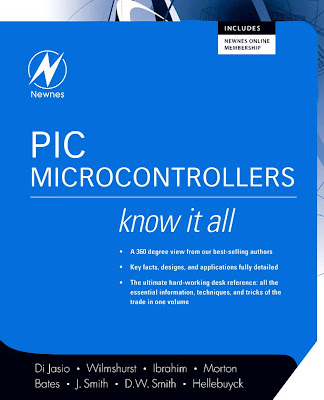 |
PIC Microcontrollers Lucio Di Jasio Tim Wilmshurst Dogan Ibrahim John Morton Martin P. Bates Jack Smith D. W. Smith Chuck Hellebuyck Reseña The Newnes Know It All Series takes the best of what our authors have written over the past few years and creates a one-stop reference for engineers involved in markets from communications to embedded systems and everywhere in between. |
| PIC design and development a natural fit for this reference series as it is one of the most popular microcontrollers in the world and we have several superbly authored books on the subject. This material ranges from the basics to more advanced topics. There is also a very strong project basis to this learning. The average embedded engineer working with this microcontroller will be able to have any question answered by this compilation. He/she will also be able to work through real-life problems via the projects contained in the book. The Newnes Know It All Series presentation of theory, hard fact, and project-based direction will be a continual aid in helping the engineer to innovate in the workplace. Newnes lo sabe todo, la Series toma lo mejor de nuestros autores han escrito en los últimos años, y crea una referencia única para los ingenieros que participan en los mercados de las comunicaciones en los sistemas embebidos y en todas partes en el medio. PIC diseño y desarrollo de un paso natural para esta serie de referencia ya que es uno de los microcontroladores más populares en el mundo y tenemos varios libros magníficamente autor sobre el tema. Este material va desde lo básico hasta temas más avanzados. Hay también una base de proyecto muy fuerte a este aprendizaje. El ingeniero de media incrustado trabajar con este microcontrolador será capaz de tener cualquier pregunta contestada por esta compilación. Él / ella también será capaz de trabajar a través de problemas reales a través de los proyectos contenidos en el libro. Newnes lo sabe todo, la Serie presentación de la teoría, basado en proyectos dirección será una ayuda constante para ayudar al ingeniero de innovar en el lugar de trabajo. |
| INDICE |
|
| Consulta el Libro (15 MB) por: |
| Para los que usan Gestores de Descarga |
http://adf.ly/MUtRT
http://adf.ly/MUtRW
http://adf.ly/MUtRZ
http://adf.ly/MUtRa
|
INDICE GENERAL |
|

No hay comentarios:
Publicar un comentario
Me gustaría Saber: Quién eres y de Donde Eres. Deja de Ser un Anónimo. Que tengas un Buen Día.